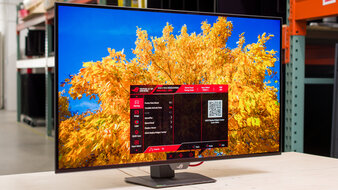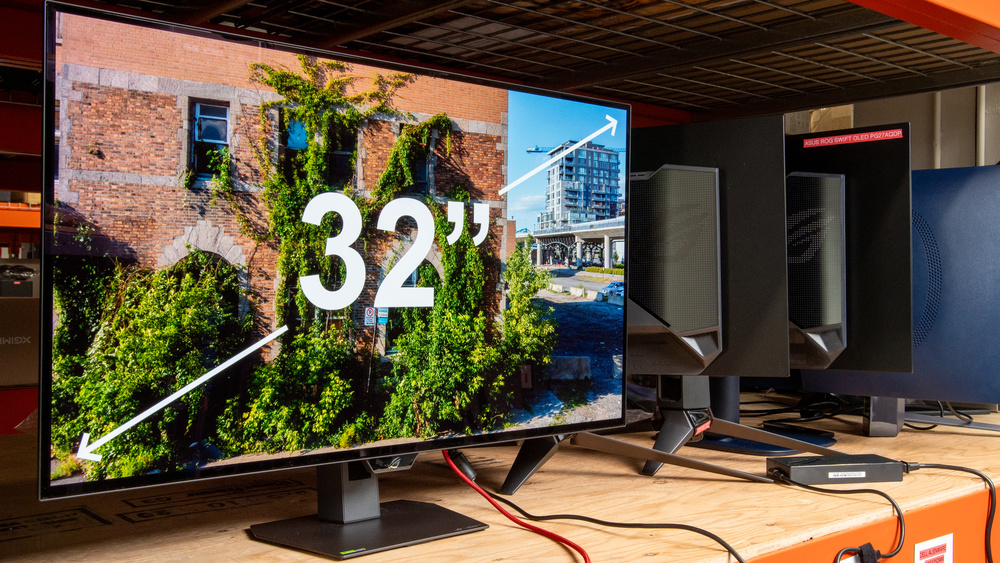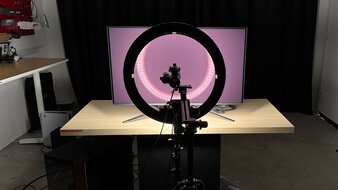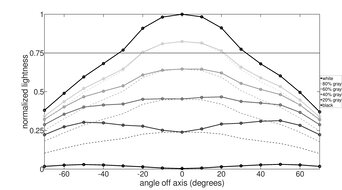A 32-inch monitor has many benefits, offering more screen space to multitask or for an immersive gaming experience compared to a smaller 27-inch display. There are a ton of great options to choose from, including with 1440p and 4k resolutions. Many have gaming features, and premium models tend to have HDMI and DisplayPort 2.1 bandwidth to take full advantage of modern graphics cards or gaming consoles. However, lower-end 32-inch models aren't as common, and they tend to cost more and don't perform as well as smaller entry-level monitors.
When looking for a new monitor, it's important to consider your budget and what you need it for. If you want a gaming display, having a fast response time and low input lag helps result in a responsive gaming experience, but most monitors have low input lag anyway. On the other hand, a wide viewing angle and high brightness are useful for work. There's no perfect solution for everyone, but understanding the available options and your needs is a good place to start.
We've bought and tested over 375 monitors, and below, you'll find our top picks for the best 32-inch monitors available to buy. If you're interested in other sizes, see our recommendations for the best 24-25 inch monitors, the best 27-inch monitors, and the best 34-49 inch monitors. If you want more info about monitor sizes, check out the best monitor sizes for gaming and our monitor sizing guide.
Quick Look





Looking to save on your next monitor? We've got you covered! Check out our Early Black Friday 2025 Deals article to see what's worthwhile this year.
-
Best 32-Inch Monitor
 Office7.9PC Gaming9.2Console Gaming9.2Editing9.0Brightness7.2Response Time9.8HDR Picture8.9SDR Picture9.9Color Accuracy8.5Size32"Pixel TypeOLEDMax Refresh Rate480 HzSee all our test resultsNative Resolution3840 x 2160
Office7.9PC Gaming9.2Console Gaming9.2Editing9.0Brightness7.2Response Time9.8HDR Picture8.9SDR Picture9.9Color Accuracy8.5Size32"Pixel TypeOLEDMax Refresh Rate480 HzSee all our test resultsNative Resolution3840 x 2160The ASUS ROG Strix OLED XG32UCWMG is the best 32-inch monitor we've tested. It has an OLED display with a native 4k resolution and a 240Hz refresh rate. It has a dual-mode feature that boosts the refresh rate to 480Hz with a lower 1080p resolution, also making it the best 32-inch gaming monitor you can get. This makes it versatile for different types of gamers, as you can play detailed games in the 4k mode and get a smoother feel with higher frame rates in the 1080p mode. It also offers fantastic gaming performance thanks to its near-instantaneous response time at any refresh rate, so motion looks sharp. Its HDMI 2.1 bandwidth helps if you have a graphics card that also supports HDMI 2.1, but the monitor doesn't support DisplayPort 2.1 bandwidth.
Besides its fantastic gaming perks, it also delivers superb picture quality. Its OLED panel displays deep and inky blacks without any haloing around bright objects, and highlights stand out for an impactful HDR experience. It uses a TrueBlack glossy coating that helps retain these black levels low even in a bright room, and it makes images look clear.
-
Best Upper Mid-Range 32-Inch Monitor
 Office7.6PC Gaming9.1Console Gaming9.2Editing8.9Brightness7.0Response Time9.9HDR Picture9.4SDR Picture10Color Accuracy8.2Size32"Pixel TypeQD-OLEDMax Refresh Rate240 HzSee all our test resultsNative Resolution3840 x 2160
Office7.6PC Gaming9.1Console Gaming9.2Editing8.9Brightness7.0Response Time9.9HDR Picture9.4SDR Picture10Color Accuracy8.2Size32"Pixel TypeQD-OLEDMax Refresh Rate240 HzSee all our test resultsNative Resolution3840 x 2160If the ASUS ROG Strix OLED XG32UCWMG is too expensive for you, the ASUS ROG Swift OLED PG32UCDM is worth getting at a lower cost when you can find it on sale. It's a 4k, 240Hz OLED like the XG32UCWMG, but there are a few trade-offs to getting this monitor. It doesn't have a dual mode that you can use to boost the refresh rate with a lower resolution. Another difference is that it uses a QD-OLED panel that lacks a polarizer, so the black levels rise in bright rooms, making them look purple. You need to use the monitor in a dark room to get those deep and inky blacks that OLEDs are known for. Also, the panel uses a triangular subpixel layout, resulting in more fringing around text than the XG32UCWMG.
Despite these differences, the PG32UCDM is still a fantastic monitor. Its near-instantaneous response time means motion looks sharp, it makes highlights pop, and bright colors are more vivid on it. It also has some productivity perks, including 90W of power delivery over USB-C. However, OLEDs like this and the XG32UCWMG risk burn-in with constant exposure to the same static elements over time, like if you only use it for work. The BenQ MOBIUZ EX321UX is an alternative that uses Mini LED backlighting and doesn't risk burn-in. However, it has a lower refresh rate and worse motion handling than the PG32UCDM.
-
Best Mid-Range 32-Inch Monitor
 Office8.1PC Gaming7.3Console Gaming8.2Editing7.8Brightness7.5Response Time8.0HDR Picture5.4SDR Picture7.4Color Accuracy8.9Size32"Pixel TypeIPSMax Refresh Rate144 HzSee all our test resultsNative Resolution3840 x 2160
Office8.1PC Gaming7.3Console Gaming8.2Editing7.8Brightness7.5Response Time8.0HDR Picture5.4SDR Picture7.4Color Accuracy8.9Size32"Pixel TypeIPSMax Refresh Rate144 HzSee all our test resultsNative Resolution3840 x 2160If the ASUS ROG Swift OLED PG32UCDM is still too much out of your price range, or if you can't find it on sale, the LG 32GR93U-B is a good mid-range alternative. Although it has a 4k resolution like the ASUS, leading to sharp and detailed images, there are a few trade-offs for getting it, as it has a step-down in picture quality. It doesn't have an OLED panel, and because it has a low contrast ratio without a local dimming feature, blacks look gray against bright objects, and highlights don't pop in HDR.
While it's worse than the ASUS to use in dark environments, it's still a good choice to use in a bright room. It gets bright enough to fight glare in most well-lit rooms, but reflections are distracting if you place it opposite a sunny window. Although it doesn't have any office-specific features, and its stand doesn't offer swivel adjustment, it's still good enough to use for work as text looks sharp. Plus, it doesn't risk burn-in with constant exposure to the same static elements, so you can use it for work everyday and not worry about damaging the screen over time.
-
Best Budget 32-Inch Monitor
 Office7.4PC Gaming7.6Console Gaming7.3Editing7.4Brightness7.7Response Time7.8HDR Picture6.4SDR Picture7.6Color Accuracy8.5Size32"Pixel TypeVAMax Refresh Rate180 HzSee all our test resultsNative Resolution2560 x 1440
Office7.4PC Gaming7.6Console Gaming7.3Editing7.4Brightness7.7Response Time7.8HDR Picture6.4SDR Picture7.6Color Accuracy8.5Size32"Pixel TypeVAMax Refresh Rate180 HzSee all our test resultsNative Resolution2560 x 1440If you're looking for a 32-inch monitor on a budget, there are a few good options, but you'll have to sacrifice performance. A monitor like the Dell Alienware AW3225DM is decent overall, but it's a step down compared to the LG 32GR93U-B. It has a lower 1440p resolution, so text doesn't look as sharp and images aren't as detailed. You can consider the Dell S3225QS if you want a 4k, 32-inch monitor for work on a budget, but it has a lower refresh rate than the AW3225DM.
This monitor has some useful gaming perks, like the fact that it has a higher 180Hz max refresh rate than the LG. Although it has more smearing and blur than the LG with fast-moving objects, motion still looks better than most 32-inch monitors with a VA panel like this one. It also has a higher contrast than the LG, so it displays fairly deep blacks in dark rooms, but it has a terrible local dimming feature that makes the picture quality worse in HDR due to haloing. On the plus side, this monitor gets very bright, which is a nice touch for an entry-level monitor, so it's decent to use in a well-lit room.
Notable Mentions
-
LG 32GS95UE-B:
The LG 32GS95UE-B is a high-end 4k, 240Hz OLED with a 1080p, 480Hz dual mode. It competes against the ASUS ROG Strix OLED XG32UCWMG, but the main difference is that the LG uses a matte coating. It absorbs light better than the glossy coating of the ASUS, but results in more haze added to the image.
See our review -
Dell S3225QC:
The Dell S3225QC is a 4k QD-OLED that costs less than the ASUS ROG Swift OLED PG32UCDM, as it has a lower refresh rate. It's worth considering if you don't need the 240Hz refresh rate of the ASUS. However, the Dell can be harder to find.
See our review -
MSI MPG 322URX QD-OLED:
The MSI MPG 322URX QD-OLED is a 4k, 240Hz QD-OLED that's similar to the ASUS ROG Swift OLED PG32UCDM. The MSI performs similarly, and the main advantage of getting it is that it has DisplayPort 2.1 bandwidth. This is useful if you have a graphics card that supports DisplayPort 2.1, but it costs more than the ASUS.
See our review -
Dell U3225QE:
The Dell U3225QE is a premium 4k work monitor that's packed with a ton of productivity features. It's something to consider if you need a 32-inch monitor for work and want an included USB hub with Thunderbolt 4 support. However, it costs more than other LED options recommended above, like the LG 32GR93U-B, so you have to be willing to pay more for its features.
See our review
Recent Updates
Nov 26, 2025:
We replaced the ASUS ROG Swift OLED PG32UCDM with the ASUS ROG Strix OLED XG32UCWMG as the 'Best 32-Inch Monitor' because the XG32UCWMG has a dual-mode feature that boosts the refresh rate. We renamed the PG32UCDM as the 'Best Upper Mid-Range 32-Inch Monitor' and removed the BenQ MOBIUZ EX321UX, which is harder to find. In the Notable Mentions, we added the Dell S3225QC.
Sep 09, 2025:
We replaced the MSI MPG 321URX QD-OLED with the ASUS ROG Swift OLED PG32UCDM for consistency with other recommendations, as the ASUS has more features. We also replaced the Samsung Odyssey Neo G8 S32BG85 with the BenQ MOBIUZ EX321UX because the BenQ is better overall. Lastly, we replaced the Samsung Odyssey G65D S32BG65D and the LG 32GN650-B/32GN63T-B, which are hard to find, with the Dell Alienware AW3225DM. We also removed the Dell S3221QS from the Notable Mentions.
Apr 25, 2025:
We replaced the Gigabyte M32U with the LG 32GR93U-B as the Gigabyte is hard to find. We also replaced the Samsung Odyssey OLED G80SD S32DG80 with the MSI MPG 322URX QD-OLED and the Dell U3225QE in the Notable Mentions.
Feb 19, 2025:
We replaced the Samsung Odyssey OLED G8/G80SD S32DG80 with the MSI MPG 321URX QD-OLED for consistency with other articles and moved the Samsung to the Notable Mentions. We also introduced a new format to the article and updated the text to reflect these changes.
Dec 11, 2024:
We replaced the Samsung Odyssey Neo G7 S32BG75 with the Samsung Odyssey Neo G8 S32BG85, which is easier to find. We also replaced the LG 32GP850-B/32GP83B-B with the Samsung Odyssey G6/G65D S32BG65D because it's cheaper. Lastly, we removed the Dell Alienware AW3225QF from the Notable Mentions and added the ASUS ROG Swift OLED PG32UCDM and LG 32GS95UE-B to better represent the current market.
All Reviews
Our recommendations are based on what we think are the best 32-inch monitors currently available, including the best 32-inch gaming monitors. They are adapted to be valid for most people in each price range. The rating is based on our review, factoring in price and feedback from our visitors.
If you would prefer to make your own decision, here is the list of all of our 32-inch monitor reviews. Be careful not to get too caught up in the details. Most monitors are good enough to please most people, and the things we fault monitors on are often not noticeable unless you really look for them.












